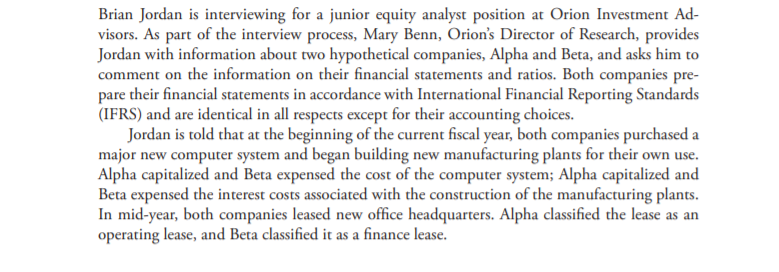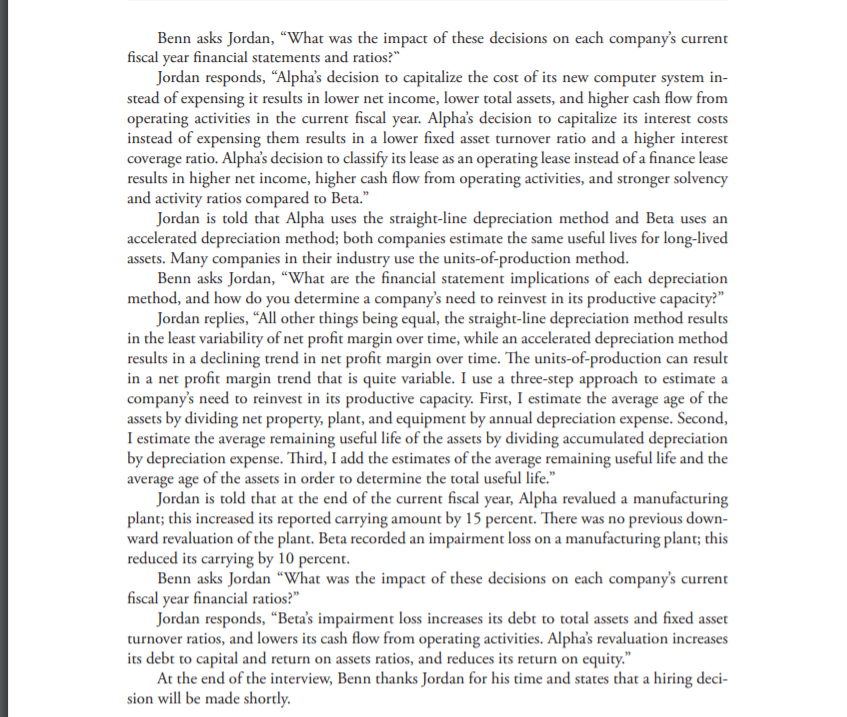Brian Jordan is interviewing for a junior equity analyst position at Orion Investment Ad- visors. As part of the interview process, Mary Benn, Orion's Director of Research, provides Jordan with information about two hypothetical companies, Alpha and Beta, and asks him to comment on the information on their financial statements and ratios. Both companies pre- pare their financial statements in accordance with International Financial Reporting Standards (IFRS) and are identical in all respects except for their accounting choices. Jordan is told that at the beginning of the current fiscal year, both companies purchased a major new computer system and began building new manufacturing plants for their own use. Alpha capitalized and Beta expensed the cost of the computer system; Alpha capitalized and Beta expensed the interest costs associated with the construction of the manufacturing plants. In mid-year, both companies leased new office headquarters. Alpha classified the lease as an operating lease, and Beta classified it as a finance lease. Benn asks Jordan, “What was the impact of these decisions on each company's current fiscal year financial statements and ratios?" Jordan responds, "Alpha's decision to capitalize the cost of its new computer system in- stead of expensing it results in lower net income, lower total assets, and higher cash flow from operating activities in the current fiscal year. Alpha's decision to capitalize its interest costs instead of expensing them results in a lower fixed asset turnover ratio and a higher interest coverage ratio. Alpha's decision to classify its lease as an operating lease instead of a finance lease results in higher net income, higher cash flow from operating activities, and stronger solvency and activity ratios compared to Beta." Jordan is told that Alpha uses the straight-line depreciation method and Beta uses an accelerated depreciation method; both companies estimate the same useful lives for long-lived assets. Many companies in their industry use the units-of-production method. Benn asks Jordan, “What are the financial statement implications of each depreciation method, and how do you determine a company's need to reinvest in its productive capacity?" Jordan replies, “All other things being equal, the straight-line depreciation method results in the least variability of net profit margin over time, while an accelerated depreciation method results in a declining trend in net profit margin over time. The units-of-production can result in a net profit margin trend that is quite variable. I use a three-step approach to estimate a company's need to reinvest in its productive capacity. First, I estimate the average age of the assets by dividing net property, plant, and equipment by annual depreciation expense. Second, I estimate the average remaining useful life of the assets by dividing accumulated depreciation by depreciation expense. Third, I add the estimates of the average remaining useful life and the average age of the assets in order to determine the total useful life." Jordan is told that at the end of the current fiscal year, Alpha revalued a manufacturing plant; this increased its reported carrying amount by 15 percent. There was no previous down- ward revaluation of the plant. Beta recorded an impairment loss on a manufacturing plant; this reduced its carrying by 10 percent. Benn asks Jordan “What was the impact of these decisions on each company's current fiscal year financial ratios?" Jordan responds, "Beta's impairment loss increases its debt to total assets and fixed asset turnover ratios, and lowers its cash flow from operating activities. Alpha's revaluation increases its debt to capital and return on assets ratios, and reduces its return on equity." At the end of the interview, Benn thanks Jordan for his time and states that a hiring deci- sion will be made shortly.
Brian Jordan is interviewing for a junior equity analyst position at Orion Investment Ad- visors. As part of the interview process, Mary Benn, Orion's Director of Research, provides Jordan with information about two hypothetical companies, Alpha and Beta, and asks him to comment on the information on their financial statements and ratios. Both companies pre- pare their financial statements in accordance with International Financial Reporting Standards (IFRS) and are identical in all respects except for their accounting choices. Jordan is told that at the beginning of the current fiscal year, both companies purchased a major new computer system and began building new manufacturing plants for their own use. Alpha capitalized and Beta expensed the cost of the computer system; Alpha capitalized and Beta expensed the interest costs associated with the construction of the manufacturing plants. In mid-year, both companies leased new office headquarters. Alpha classified the lease as an operating lease, and Beta classified it as a finance lease. Benn asks Jordan, “What was the impact of these decisions on each company's current fiscal year financial statements and ratios?" Jordan responds, "Alpha's decision to capitalize the cost of its new computer system in- stead of expensing it results in lower net income, lower total assets, and higher cash flow from operating activities in the current fiscal year. Alpha's decision to capitalize its interest costs instead of expensing them results in a lower fixed asset turnover ratio and a higher interest coverage ratio. Alpha's decision to classify its lease as an operating lease instead of a finance lease results in higher net income, higher cash flow from operating activities, and stronger solvency and activity ratios compared to Beta." Jordan is told that Alpha uses the straight-line depreciation method and Beta uses an accelerated depreciation method; both companies estimate the same useful lives for long-lived assets. Many companies in their industry use the units-of-production method. Benn asks Jordan, “What are the financial statement implications of each depreciation method, and how do you determine a company's need to reinvest in its productive capacity?" Jordan replies, “All other things being equal, the straight-line depreciation method results in the least variability of net profit margin over time, while an accelerated depreciation method results in a declining trend in net profit margin over time. The units-of-production can result in a net profit margin trend that is quite variable. I use a three-step approach to estimate a company's need to reinvest in its productive capacity. First, I estimate the average age of the assets by dividing net property, plant, and equipment by annual depreciation expense. Second, I estimate the average remaining useful life of the assets by dividing accumulated depreciation by depreciation expense. Third, I add the estimates of the average remaining useful life and the average age of the assets in order to determine the total useful life." Jordan is told that at the end of the current fiscal year, Alpha revalued a manufacturing plant; this increased its reported carrying amount by 15 percent. There was no previous down- ward revaluation of the plant. Beta recorded an impairment loss on a manufacturing plant; this reduced its carrying by 10 percent. Benn asks Jordan “What was the impact of these decisions on each company's current fiscal year financial ratios?" Jordan responds, "Beta's impairment loss increases its debt to total assets and fixed asset turnover ratios, and lowers its cash flow from operating activities. Alpha's revaluation increases its debt to capital and return on assets ratios, and reduces its return on equity." At the end of the interview, Benn thanks Jordan for his time and states that a hiring deci- sion will be made shortly.
Chapter4: Ethical Responsibilities Of Accountants
Section4.4: Freescale Semiconductor, Inc.
Problem 2Q
Related questions
Question
Jordan’s response about the ratio impact of Alpha’s decision to capitalize interest costs is
most likely correct with respect to the:
A. interest coverage ratio.
B. fixed asset turnover ratio.
C. interest coverage and fixed asset turnover ratios.

Transcribed Image Text:Brian Jordan is interviewing for a junior equity analyst position at Orion Investment Ad-
visors. As part of the interview process, Mary Benn, Orion's Director of Research, provides
Jordan with information about two hypothetical companies, Alpha and Beta, and asks him to
comment on the information on their financial statements and ratios. Both companies pre-
pare their financial statements in accordance with International Financial Reporting Standards
(IFRS) and are identical in all respects except for their accounting choices.
Jordan is told that at the beginning of the current fiscal year, both companies purchased a
major new computer system and began building new manufacturing plants for their own use.
Alpha capitalized and Beta expensed the cost of the computer system; Alpha capitalized and
Beta expensed the interest costs associated with the construction of the manufacturing plants.
In mid-year, both companies leased new office headquarters. Alpha classified the lease as an
operating lease, and Beta classified it as a finance lease.

Transcribed Image Text:Benn asks Jordan, “What was the impact of these decisions on each company's current
fiscal year financial statements and ratios?"
Jordan responds, "Alpha's decision to capitalize the cost of its new computer system in-
stead of expensing it results in lower net income, lower total assets, and higher cash flow from
operating activities in the current fiscal year. Alpha's decision to capitalize its interest costs
instead of expensing them results in a lower fixed asset turnover ratio and a higher interest
coverage ratio. Alpha's decision to classify its lease as an operating lease instead of a finance lease
results in higher net income, higher cash flow from operating activities, and stronger solvency
and activity ratios compared to Beta."
Jordan is told that Alpha uses the straight-line depreciation method and Beta uses an
accelerated depreciation method; both companies estimate the same useful lives for long-lived
assets. Many companies in their industry use the units-of-production method.
Benn asks Jordan, “What are the financial statement implications of each depreciation
method, and how do you determine a company's need to reinvest in its productive capacity?"
Jordan replies, “All other things being equal, the straight-line depreciation method results
in the least variability of net profit margin over time, while an accelerated depreciation method
results in a declining trend in net profit margin over time. The units-of-production can result
in a net profit margin trend that is quite variable. I use a three-step approach to estimate a
company's need to reinvest in its productive capacity. First, I estimate the average age of the
assets by dividing net property, plant, and equipment by annual depreciation expense. Second,
I estimate the average remaining useful life of the assets by dividing accumulated depreciation
by depreciation expense. Third, I add the estimates of the average remaining useful life and the
average age of the assets in order to determine the total useful life."
Jordan is told that at the end of the current fiscal year, Alpha revalued a manufacturing
plant; this increased its reported carrying amount by 15 percent. There was no previous down-
ward revaluation of the plant. Beta recorded an impairment loss on a manufacturing plant; this
reduced its carrying by 10 percent.
Benn asks Jordan “What was the impact of these decisions on each company's current
fiscal year financial ratios?"
Jordan responds, "Beta's impairment loss increases its debt to total assets and fixed asset
turnover ratios, and lowers its cash flow from operating activities. Alpha's revaluation increases
its debt to capital and return on assets ratios, and reduces its return on equity."
At the end of the interview, Benn thanks Jordan for his time and states that a hiring deci-
sion will be made shortly.
Expert Solution
This question has been solved!
Explore an expertly crafted, step-by-step solution for a thorough understanding of key concepts.
This is a popular solution!
Trending now
This is a popular solution!
Step by step
Solved in 2 steps

Knowledge Booster
Learn more about
Need a deep-dive on the concept behind this application? Look no further. Learn more about this topic, finance and related others by exploring similar questions and additional content below.Recommended textbooks for you


Principles of Accounting Volume 1
Accounting
ISBN:
9781947172685
Author:
OpenStax
Publisher:
OpenStax College


Principles of Accounting Volume 1
Accounting
ISBN:
9781947172685
Author:
OpenStax
Publisher:
OpenStax College